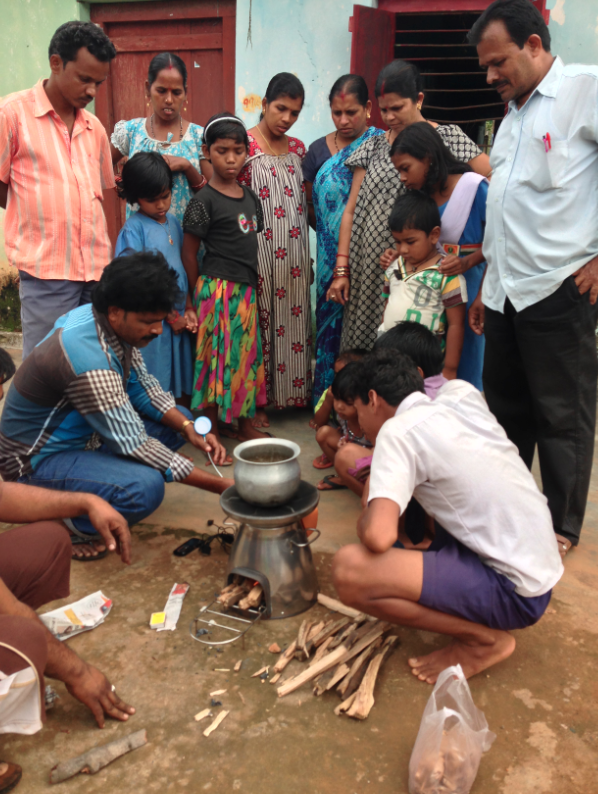Brooklyn’s BioLite Home Stove has been designed in Dumbo to deliver a healthier cooking experience to people in the developing world who still use traditional fuels. Not only that, but it also allows them to charge their electronic devices or run an LED light. The company was recently named by Business Insider as one of Brooklyn’s hottest tech startups, but the only one literally in the fire business.
Much of the world still cooks over an open fire. In what’s known as the three stone method, where a fire is built with wood or coal between three large stones, and a pot or other cooking surface is placed atop the stones. Now, there’s nothing like a nice camp fire, from time to time, but anyone who has ever sat in front of a campfire knows that getting its smoke in your face feels toxic.
Because it is.
So imagine how it is for people who always cook like that. That’s a lot of blasts of smoke in the face, over a lifetime. Most of those toxic blasts of smoke are going in the faces of women, who do much of the world’s cooking and their children, who are either hanging around near mom, or, worse, growing inside her. The World Health Organization has a fact sheet on the real world consequences of cooking over open fires indoors, including ascribing 50% of all pneumonia deaths in children under 5 to indoor smoke and two million premature deaths annually to it.
BioLite stoves create more efficient combustion from traditional fuels, yielding more heat and less smoke. They do this by using Thermoelectric Generators to power a fan that blows additional air onto the fire, which generates more heat and more electricity. The extra electricity is what enables it to power up phones as well. It’s explained here. They are working to make a real product that is affordable for developing world families to use in order to create a market based solution to public health problems.
Note that phones aren’t a luxury in these places. In much of Africa, in particular, mobile phones are how business gets done.
Technically Brooklyn reached out to BioLite team members working in India and Africa to ask about the progress of selling the stove and developing a program to create a sustainable market for the stove and verify that it is creating real progress in public health.
In India

Arley Smude is the staff member responsible for building a sales team in India. He explained his role both in building a well-informed, well-trained sales staff, to show the HomeStoves to families in India.
Smude described how he was surprised to see that what most impressed people in India about the stove was how it cooks. Its electricity generation is something people like a lot, but they can really see the difference in the quality of the flame right away. He’s learned to make that the focus when he presents the stove to new communities.
That said, neither of the staff we spoke to hesitated at all to acknowledge that people can be reluctant to abandon traditional methods. That’s why the HomeStove was designed to reflect those traditional practices and the team continues to remain cognizant of this issue.
Smude told us: “Despite people being impressed with the stove, that’s not always enough for them to take the jump to a new technology. To address this we’re working with MIT’s Jameel Poverty Action Lab to test the effectiveness of a risk-free trial to mitigate risk aversion.”
J-PAL is also working with BioLite in 88 Indian villages, according to Smude, to study strategies for improving adoption, the differences in health benefits and whether financing strategies make a difference for potential customers.
Because the stove cooks food faster and requires less fuel, it’s saving women time on preparing their families’ food, which yields real returns, according to both of the on-the-ground BioLite staff we spoke to.
“For example, a woman in Budhoda Village outside the city of Latur, Surekha, explained to me that she was able to spend more time in the soybean field and take more orders for mending and tailoring on her sewing machine,” he said.
In Uganda and Ghana

The BioLite program in Uganda is experimenting with ways to make the stove more affordable by subsidizing its cost through carbon credits — prompting carbon measuring devices inside many of them.
If the company can show, over time, that the stoves demonstrably reduce carbon emissions from traditional cooking, they can sell that difference as a credit on the carbon market and use the income to offset the price of HomeStoves, making them more affordable. To accomplish this, the company is working with Impact Carbon to generate hard data on the carbon savings of the stove.
Sophie Gagnon is running BioLite‘s on-the-ground Africa program. When we reached her, she was working in Ghana, where the company is working on another study on the benefits of using the product. Columbia University is studying three villages there to determine the difference home stoves make on baby weight and infant mortality — called the largest cooking-related health study ever undertaken.
Gagnon told us, “There are two control groups, one where women cook on a traditional open fire, and a second where they use [a liquid petroleum gas] stove. We’re hoping that the smoke emission reduction of the HomeStove will reduce the risk of pre-natal and infant respiratory diseases and increase child birth weight.”
The company’s technology is available in the developed world, too, including their CampStove, a camping product that’s about the size of a Nalgene bottle.
In late 2011, the company announced $1.8 million in Series A financing, led by Disruptive Innovation Fund. It currently has 31 employees.
The below video both explains the CampStove and connects it back to the HomeStove that Smude and Gagnon are working to market in parts of the developing world.







